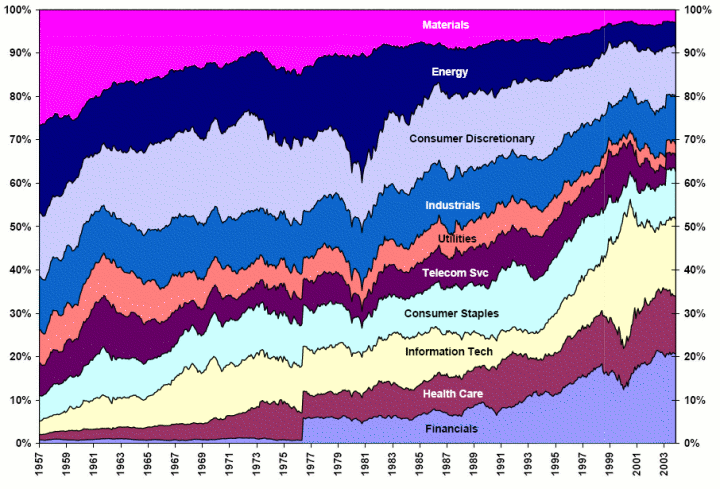For three decades, the market value of the financial services industry segment within the Standard and Poors 500 composite index rose steadily to reach 21% in the middle of 2007.
This article updates an August 2007 article, “The Biggest Personal Finance Story of the Past 30 Years,” which was published just as the real estate bubble was showing early signs of deflation and the credit crunch and attendant economic crisis were arriving. In the summer of 2007, however, few outside the securities industry appreciated how much economic damage easy credit and risky bond derivatives associated with the housing bubble could cause. Now, as the credit crunch has spread across the US economy and over the world, everyone is being affected by problems rooted in greed and financial mis-management by the financial services industry.
The August 2007 article discussed the thirty years of growth of financial services industry asset values on US stock markets. The US financial services industry includes stock brokerage firms, investment firms, mortgage companies, insurance companies, credit card companies, banks, and other publicly traded financial businesses. Each of these financial industry sub sectors provides valuable and necessary services. Yet the “hidden” story for financial services consumers is that consumers have paid far too much for far too long for far too little. Consumers have fueled much of the profit growth of the financial services sector and in aggregate financial services consumers have been the losers.
Over thirty years, the financial services sector became the largest US equity market sector, as it grew more rapidly than any other US industrial or service sector.
To understand what has happened to the market valuation of the financial services sector over the last 30 years, you should read the financial study by Jeremy Siegel and Jeremy Schwartz entitled: “The Long-term Returns on the Original S&P 500 Firms.” This is an Adobe Acrobat document on The Wharton School of Business website at the University of Pennsylvania. Be patient as it loads. Figure 4 entitled “Market Sector Share, 1957-2003” from page 16 of this study is reproduced below.
Market Sector Share 1957-2003 – S&P 500 Composite Index – Jeremy Siegel and Jeremy Schwartz – “The Long-term Returns on the Original S&P 500 Firms”
 In addition to the point that this article makes regarding Figure 4, the remainder of this Siegel and Schwartz paper is well worth your time to read. This investment study showed that revisions to the S&P500 index over time had not enhanced the value to investors. A completely passive, extremely long-term strategy of buying and holding the original S & P 500 firms, from when the index first held 500 companies in 1957 was superior strategy, because:
In addition to the point that this article makes regarding Figure 4, the remainder of this Siegel and Schwartz paper is well worth your time to read. This investment study showed that revisions to the S&P500 index over time had not enhanced the value to investors. A completely passive, extremely long-term strategy of buying and holding the original S & P 500 firms, from when the index first held 500 companies in 1957 was superior strategy, because:
1) new stocks tended to be added to the S and P 500 composite index, when their relative valuations were peaking, and
2) unfavorable market trading costs weighed down returns, when firms were added to or dumped from the index.
This study is yet another proof that a very passive, low cost, buy-and-hold strategy is usually superior over the very long haul — even for index mutual funds. In addition, a large body of investment research literature has firmly established that the frenetic active investing that so many individuals and investment funds do is a waste of money, taxes, and time to the average individual investor.
The value of the US financial services sector in the S&P 500 composite index grew from next to nothing to become about 20% of index value by 2003.
When you looked at Figure 4 of the Siegel and Schwartz paper, did anything seem stunning to you? I was stunned, when I first saw this graphic. No other sector has grown like the Financial sector has. Note that while Standard and Poors has published the S&P composite index since 1923, it was not until 1957 that the S & P composite index first had 500 equities.
Figure 4 of the Siegel and Schwartz paper indicates that financial companies were a trivial part of the S&P 500 index until 1976. Siegel and Schwartz suggest that part of the reason was that “The only financial stocks in the index in 1957 were consumer finance companies, such as Household International, Beneficial Corp, and CIT Financial. Banks were not added to the Index until 1976. One of the reasons given for the early exclusion of bank stocks was that most banks were trading on the over-the-counter exchange (which became Nasdaq in 1971) and timely price data were not available.” (See footnote 8 on page 4)
In 1976, 40 financial services firms were added, when the total Financial sector share of S&P500 index capitalization was only about 6%. In the three decades since 1976, the Financial sector’s market capitalization percentage growth has been dramatic and relatively steady. In terms of the Financial sector’s relative share, the dot com bubble temporarily depressed the Financial sector’s overall market share, but Financials’ share snapped back to its upward growth trend line following the collapse of the bubble.
After its recent decline, at 16% of S&P 500 composite index market capitalization in early 2008, financial services is still the largest US large stock market sector.
Notwithstanding the recent credit crunch collapse of this industry’s equity market values, the US financial services sector still is the largest sector within the S&P 500 composite index. Despite stock market declines, at the end of the first quarter of 2008 the financial services sector was still 16.8% of total S & P 500 composite index market capitalization.
Is the recent collapse of financial services sector stock market values just temporary?
Despite the financial industry’s recent self-immolation and the setback in its stock values, there is no reason to believe that financial services industry equity values will not recover and keep growing, perhaps surpassing its 21% of total capitalization in mid-2007. Financial services sector equity market values rose, crashed, and will rise again, in part, because the mass of American consumers are just like trusting, docile sheep regarding their personal financial affairs and the amount they are willing to waste on overpriced financial services.
Far too many US consumers pay far too much and get woefully little value in return from the financial services industry, including its securities and investment sector. The industry repeatedly scrapes the consumer excess off the table and stuffs it into its salaries, bonuses, and corporate earnings reports. Consumer overcharges just drive up the portfolio values of those who own its financial services industry equities. There really is no reason to believe that things will ever change.





















